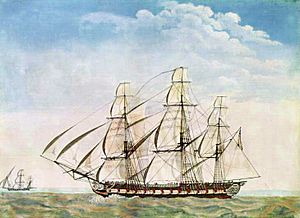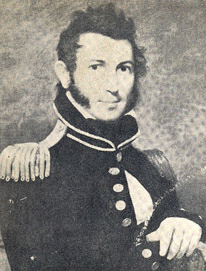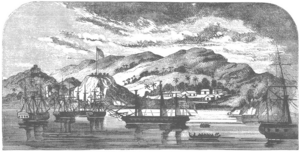Action off Charles Island facts for kids
Quick facts for kids Action off Charles Island |
|||||||
|---|---|---|---|---|---|---|---|
| Part of War of 1812 | |||||||
 USS Essex off Galapagos. |
|||||||
|
|||||||
| Belligerents | |||||||
| Commanders and leaders | |||||||
| Strength | |||||||
| 1 frigate 2 sloops-of-war |
3 armed whaling brigs | ||||||
| Casualties and losses | |||||||
| 1 sloop-of-war damaged | 89 men captured, of which 48 were released on parole after the battle 3 brigs captured |
||||||
The action off Charles Island was a naval battle during the War of 1812. It happened in the summer of 1813 near Charles Island in the Galapagos. During this fight, three American ships attacked and captured three British whaling ships. This battle was special because it was one of the few naval fights in the Pacific Ocean during the war. It also involved U.S. Marine Lieutenant John M. Gamble, who was the first U.S. Marine to command an American warship.
Setting the Scene
The War of 1812 was fought between the United Kingdom and the United States. American Captain David Porter commanded the thirty-six gun frigate USS Essex. A frigate is a fast warship with many guns. Captain Porter led a group of armed ships in the South Pacific. Their mission was to attack British merchant ships and whalers. This type of attack is called "commerce raiding."
At the time of this battle, Essex was sailing with two smaller ships. These ships were recently captured from the British. Captain Porter called them sloops-of-war. A sloop-of-war is a smaller warship, often with one deck of guns. These two ships were the 10-gun Greenwich and the 8-gun Georgiana. Captain Porter had sent the rest of his fleet to Valparaiso, Chile, to be sold. He and his remaining ships were looking for British whalers between Tumbes, Peru, and the Galapagos.
Captain Porter had only about 350 American sailors and Marines with him. When he captured enemy ships, he could only put small crews on them. These small groups are called "skeleton crews." The Georgiana had forty-two men, led by Mr. Adams, who was the Essex's chaplain. The Greenwich had only fourteen men. These men were led by Lieutenant Gamble of the U.S. Marines.
The Battle Begins
The exact date of the battle is a bit unclear. Lieutenant Gamble later remembered it as July 12 or 13. However, Captain Porter's own writings say it was July 14. Either way, around 11:00 AM, the American ships were sailing west. They were off Banks Bay in the Galapagos. Suddenly, they saw three sets of sails in the distance.
Captain Porter quickly signaled his ships to get ready for a fight. They began to chase the unknown ships. Most British ships sailing in the South Pacific at that time were whalers. Many of them also carried "letters of marque." This was a special permission from the government. It allowed them to act as privateers. Privateers were private ships that could legally attack enemy ships for profit.
The first British ship Captain Porter captured was the brig Charlton. A brig is a two-masted sailing ship. The Charlton had ten guns. It was sailing in the middle of the three British ships. It surrendered to Essex without a fight. Meanwhile, Greenwich and Georgiana went after the Seringapatam.
The Seringapatam was a whaling ship. It had made several trips to the South Atlantic since 1800. It had a crew of 41 men and was commanded by Captain William Stavers. It was armed with fourteen 9-pounder guns. On this trip, it had already captured one American whaler.
When Captain Stavers realized he could not escape, the Seringapatam changed course. It looked like it was going to attack Greenwich. But the Greenwich stopped and waited for Georgiana to come closer and help. At this point, Captain Stavers decided not to attack and tried to escape again.
Lieutenant Gamble on Greenwich closed the distance between the two ships. He first demanded that the British surrender. But when the American ship got very close, the Seringapatam raised its flag and fired a powerful broadside. A broadside is when all the guns on one side of a ship fire at once.
The Greenwich immediately fired back with small guns and cannons. For a few moments, the two ships exchanged fire. The American shots were more accurate. After taking heavy damage, the British ship lowered its flag, showing it surrendered. The Greenwich stopped firing. Just as Lieutenant Gamble was getting ready to board the enemy ship, the Seringapatam tried to escape again. Gamble ordered his men to shoot at the British ship's sails. This finally stopped it.
Meanwhile, the Essex had finished chasing the third British ship. This was the small 8-gun New Zealander. The Essex captured it easily. Captain Porter then helped chase down the Seringapatam.
After the Battle
There is no mention of anyone being hurt in this battle in American records. However, the Greenwich was damaged, and the Seringapatam was badly hurt. Captain Porter captured 89 prisoners in total. His ships were already full of captives. So, the Americans removed the guns from the Charlton. They put 48 of the prisoners on board. They sent the Charlton to Rio de Janeiro as a "cartel." A cartel ship is used to exchange prisoners. These prisoners were released "on parole." This meant they promised not to fight again until they were officially exchanged. They were ordered to surrender to the first American authority they met.
When Captain Stavers was asked to show his privateer's permission, he admitted he hadn't received it yet. He said it was probably waiting for him in Lima. Captain Porter announced that Stavers would be taken to the United States and tried as a pirate. He ordered Stavers and his crew to be put in chains. However, they were later given more freedom. This happened after some American whalers, who had been prisoners on the Seringapatam, told Porter that the British had treated them well.
The American newspapers said the Seringapatam was a big threat to American trade in the Pacific. This made Lieutenant Gamble famous. He received many letters of congratulations from other naval officers. The Seringapatam was found to have about $30,000 worth of weapons and supplies. Gamble was promoted to captain. He later died in 1836 as a lieutenant colonel. Even though he asked the U.S. Congress, he never received any prize money for capturing the ship or for his service.
After the battle, Captain Porter sailed to Nuku Hiva in the Marquesas. There, he built America's first naval base in the Pacific. He repaired his ships there. He then sailed away, leaving Greenwich, Seringapatam, and another captured ship, Sir Andrew Hammond, behind. After he left, a mutiny happened on the Seringapatam. A mutiny is when a crew rebels against its commander. The mutineers and British prisoners took back the Seringapatam. They sailed it to Australia, and it was returned to its owners. Lieutenant Gamble burned the Greenwich before leaving Nuku Hiva on the Sir Andrew Hammond.
Images for kids






